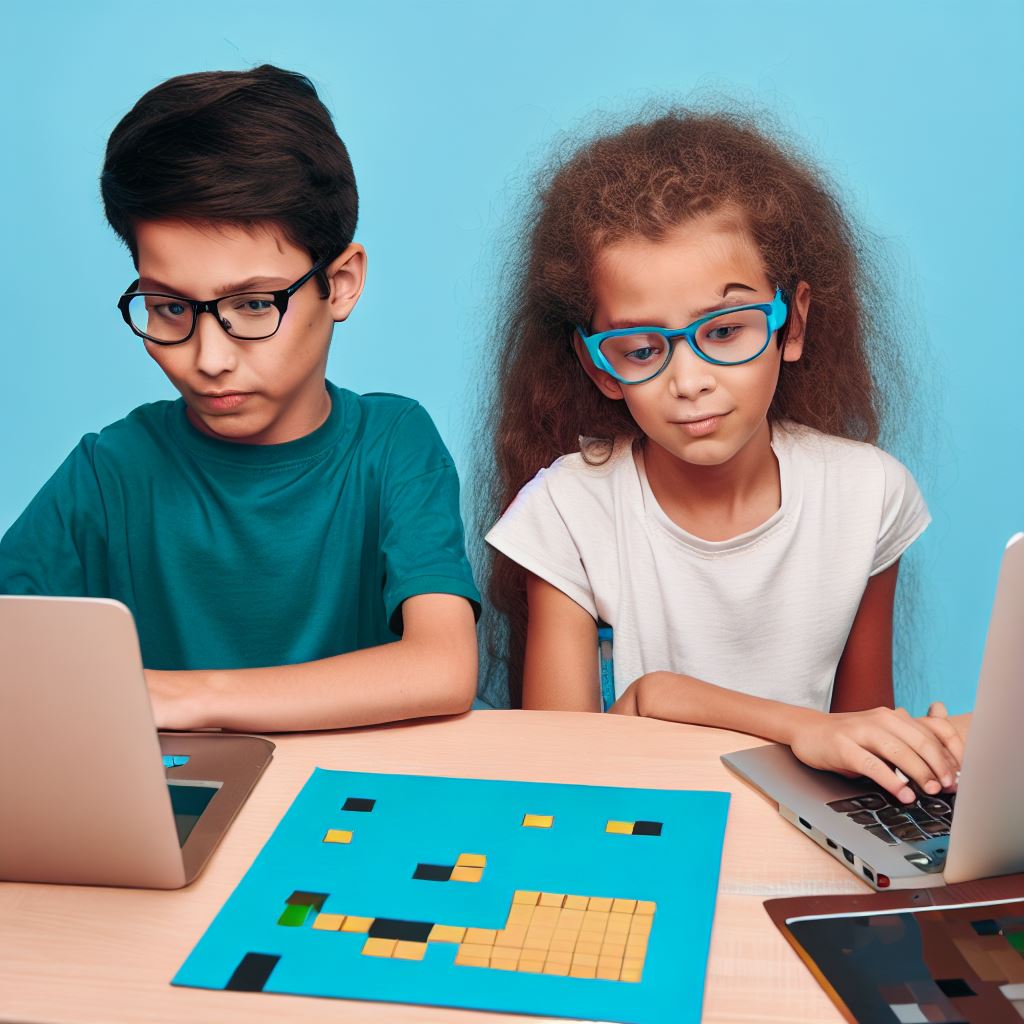Introduction
Overview of the topic
In today’s digital age, the choice between in-person vs. online coding classes for kids has become pivotal in imparting this essential skill.
Coding classes for kids are gaining popularity as parents recognize the importance of equipping their children with these skills.
Importance of coding classes for kids
Coding classes for kids not only teach them how to program, but also foster problem-solving, critical thinking, and creativity.
These classes prepare children for future job opportunities in the technology industry.
Thesis statement on comparing in-person and online coding classes for kids
This post aims to compare the pros and cons of in-person and online coding classes for kids.
It will provide insights for parents and educators in choosing the most suitable learning environment for their children.
In-person coding classes for kids: Pros and Cons
In-person coding classes offer direct interaction with instructors, allowing children to receive immediate feedback and guidance.
This fosters a supportive learning environment and builds interpersonal skills.
However, limited class sizes and location constraints may be drawbacks for some families.
Online coding classes for kids: Pros and Cons
Online coding classes offer flexibility and convenience, as children can learn from the comfort of their homes.
It provides access to a larger pool of instructors and resources.
However, the lack of in-person interaction may hinder collaborative learning and troubleshooting skills.
Basically, choosing between in-person and online coding classes for kids depends on various factors such as learning style, schedule, and access to resources.
Both options have their own advantages and disadvantages, and it is essential for parents to assess their children’s needs and preferences before making a decision.
Ultimately, the goal is to provide children with an engaging learning experience that nurtures their coding skills and sets them up for success in the digital world.
Tech Consulting Tailored to Your Coding Journey
Get expert guidance in coding with a personalized consultation. Receive unique, actionable insights delivered in 1-3 business days.
Get StartedPros of In-person Coding Classes for Kids
When it comes to coding classes for kids, there are two main options to consider: in-person classes and online classes.
Both have their advantages and disadvantages, and it’s important to weigh them carefully before making a decision.
In this section, we will explore the pros and cons of in-person coding classes for kids.
Face-to-face interaction with instructors and peers
One of the biggest advantages of in-person coding classes for kids is the opportunity for face-to-face interaction with instructors and peers.
Being physically present in a classroom allows students to ask questions, seek clarification, and engage in meaningful discussions with their instructors and classmates.
This interpersonal communication can be invaluable for learning and understanding complex coding concepts.
Hands-on learning experience
In-person coding classes provide a hands-on learning experience that online classes often lack.
Students have access to tangible resources, such as computers and coding equipment, which allow them to practice coding skills in real-time.
This hands-on approach can deepen their understanding of coding principles and enhance their problem-solving abilities.
Immediate feedback and support
Another benefit of in-person coding classes is the immediate feedback and support students receive from their instructors.
Instructors can easily identify areas where students are struggling and provide instant guidance and assistance.
This real-time feedback helps students correct their mistakes and stay on track, fostering a more efficient learning process.
Opportunities for collaboration and team building
In-person coding classes offer opportunities for collaboration and team building.
Students can work together on coding projects, share ideas, and learn from one another’s experiences.
Build Your Vision, Perfectly Tailored
Get a custom-built website or application that matches your vision and needs. Stand out from the crowd with a solution designed just for you—professional, scalable, and seamless.
Get StartedCollaborative activities promote problem-solving skills, critical thinking, and effective communication – all essential qualities for success in the coding world.
Enhanced motivation and accountability
Being in a physical classroom setting can also enhance motivation and accountability among students.
The presence of instructors and peers creates a sense of responsibility, and students are more likely to stay focused and actively participate in class.
This increased motivation can lead to greater productivity and better learning outcomes.
Generally, in-person coding classes for kids offer several advantages over online classes.
The face-to-face interaction, hands-on learning experience, immediate feedback and support, collaboration opportunities, and enhanced motivation contribute to a more comprehensive and effective learning journey.
However, it’s important to consider individual preferences, scheduling constraints, and other factors before deciding on the best learning method for a child.
Read: Coding Games for Kids: Learning Can Be Fun!
Cons of In-person Coding Classes for Kids
Geographical limitations
In-person coding classes often come with geographical constraints. Kids residing far from coding centers may face commuting challenges.
Limited class schedule options
Scheduled classes can clash with kids’ other commitments, making it challenging to juggle their activities effectively.
Higher cost compared to online classes
In-person classes tend to be pricier due to overheads like facility maintenance and materials, which can strain parents’ wallets.
Lesser flexibility in learning pace and time
In-person classes follow a set timetable, offering less flexibility in adapting to individual learning speeds and time preferences.
In-person coding classes offer valuable in-person interactions but may restrict access and flexibility, making online alternatives enticing.
Read: Teaching Kids to Code: Do’s and Don’ts for Parents
Optimize Your Profile, Get Noticed
Make your resume and LinkedIn stand out to employers with a profile that highlights your technical skills and project experience. Elevate your career with a polished and professional presence.
Get Noticed
Pros of Online Coding Classes for Kids
Flexibility in terms of schedule and location
Online coding classes offer flexibility in terms of when and where kids can learn.
They are not bound by fixed schedules and can learn at their own convenience.
This flexibility allows kids to balance their coding education with other commitments such as school, extracurricular activities, and family time.
Additionally, online classes can be accessed from any location with an internet connection.
This means that kids can learn from the comfort of their own home or even while traveling.
Lower costs compared to in-person classes
Attending in-person coding classes can be expensive, with costs including tuition fees, transportation expenses, and materials.
On the other hand, online coding classes often come at a lower price point.
Parents can save money by enrolling their kids in online classes.
Lower costs make coding education more accessible to a wider range of families, ensuring that more kids have the opportunity to learn valuable coding skills.
Wide variety of online resources and tools available
The online world offers a plethora of resources and tools for kids to enhance their coding skills.
From interactive coding platforms to educational videos and tutorials, there is a wide array of options available online.
These resources provide comprehensive learning materials that cater to different learning styles and levels of expertise.
Kids can explore various tools and find the ones that resonate with them, making their coding learning experience more enjoyable and effective.
Self-paced learning that suits individual needs
Online coding classes allow kids to learn at their own pace, ensuring that they fully understand each concept before moving on.
Unlike in-person classes, where the entire class follows the same curriculum and timetable, online classes provide personalized learning experiences.
Kids can take their time to absorb information, ask questions, and practice coding concepts until they feel confident.
This self-paced learning approach ensures that each child’s individual needs are met, resulting in better retention and understanding of coding principles.
Opportunity to gain digital literacy skills
In the digital age, digital literacy skills are essential for success.
Online coding classes provide kids with the opportunity to develop these skills from an early age.
By learning to code online, kids enhance their problem-solving abilities, critical thinking skills, and creativity.
They also learn to navigate digital platforms and gain an understanding of how technology works.
These skills are highly transferable and can benefit kids in many aspects of their lives, both academically and professionally.
Overall, online coding classes for kids offer several advantages.
They provide flexibility in terms of schedule and location, come at lower costs, offer a wide variety of resources and tools, allow for self-paced learning, and empower children to gain valuable digital literacy skills.
Parents can consider these benefits when deciding on the best coding education option for their kids.
Read: Is Coding for Kids Just a Trend or a Necessary Skill?
Cons of Online Coding Classes for Kids
Lack of face-to-face interaction and personal connection
Online coding classes for kids often lack the physical presence of instructors and classmates, resulting in a loss of face-to-face interaction and personal connection.
This can make it challenging for students to build relationships and engage in meaningful discussions.
Limited immediate guidance and support
In online coding classes, the immediate guidance and support provided by instructors may be limited.
Students may have to wait for responses to their queries, hindering their progress and delaying problem-solving.
Potential distractions and lack of structured environment
One of the drawbacks of online coding classes is the potential for distractions.
Children may be easily tempted to switch between tabs, access social media, or engage in other non-productive activities.
Moreover, the lack of a structured learning environment at home can further contribute to distractions.
Lack of hands-on learning experiences
Online coding classes may not offer the same level of hands-on learning experiences as in-person classes.
While virtual simulations and coding platforms can provide some level of interactivity, they may not fully replicate the tactile experience of physically working with equipment or devices.
Requires self-discipline and motivation from students
Participating in online coding classes requires a higher level of self-discipline and motivation from students.
Without the immediate presence of instructors or peers, children need to independently manage their time, complete assignments, and stay focused on their learning goals.
Despite the numerous benefits online coding classes offer, it is crucial to consider these cons before enrolling kids in such programs.
Balancing these factors can help parents make an informed decision about the most suitable learning environment for their children.
Read: How Coding Skills Can Help Kids in School and Life
Conclusion
Recap of pros and cons of in-person and online coding classes for kids
- In-person classes provide hands-on guidance and immediate feedback, but can be expensive and have limited availability.
- Online classes offer flexibility, lower costs, and a wide range of resources, but lack face-to-face interaction and personalized attention.
Personal considerations for choosing the most suitable option
- Consider the child’s learning style, preferences, and availability.
- Evaluate the level of parental involvement and support required.
- Weigh the importance of social interaction and collaborative learning.
- Assess the child’s self-discipline and motivation to learn independently.
Encouragement for further exploration and development of coding skills in kids
Regardless of the chosen learning method, it is crucial to nurture a child’s interest in coding.
Encourage participation in coding clubs, hackathons, and competitions to enhance skills and foster a sense of community.
Parents can also provide opportunities for real-world applications of coding knowledge through projects or internships.
By nurturing and supporting a child’s coding journey, they can develop valuable skills for future success.




